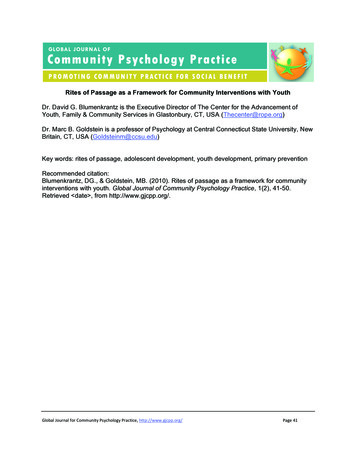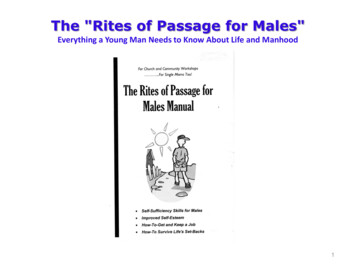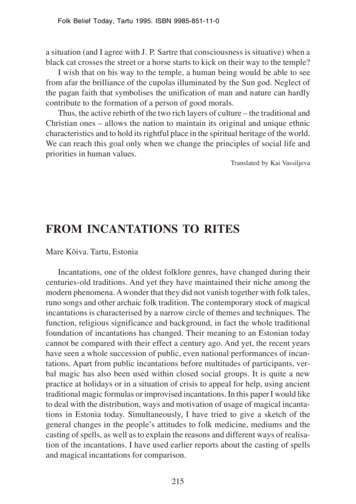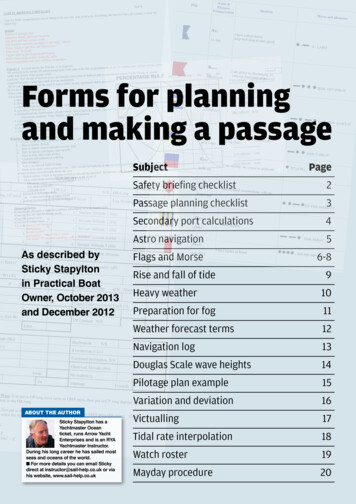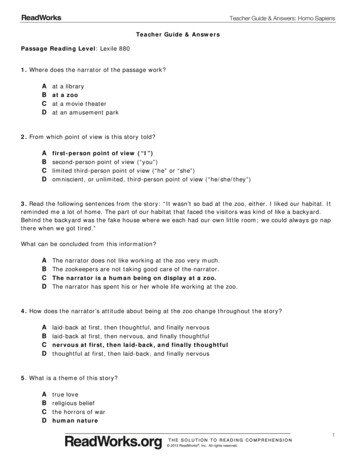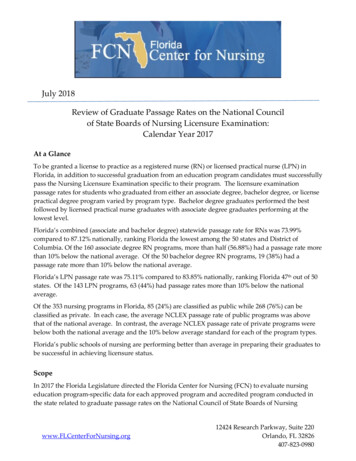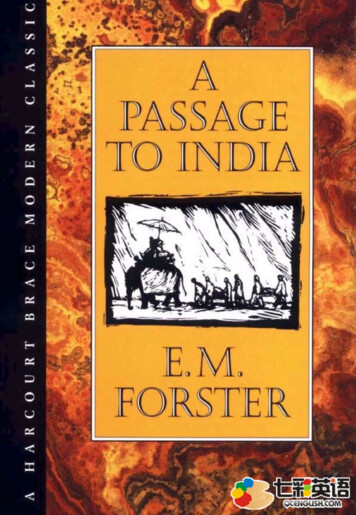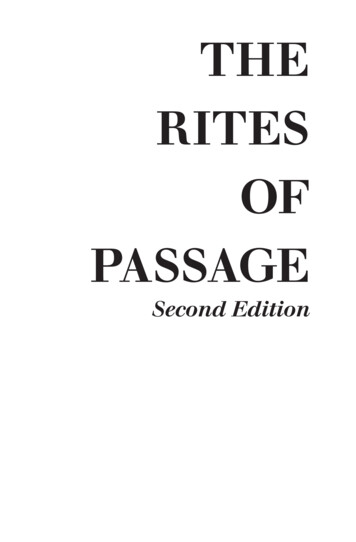
Transcription
THERITESOFPASSAGESecond Edition
CONTENTSI.Introduction to the Second Edition by David I. KertzerviiAuthor’s ForewordxlvThe Classification of Rites1II.The Territorial Passage15III.Individuals and Groups26IV.Pregnancy and Childbirth41Birth and Childhood50Initiation Rites65V.VI.VII.VIII.IX.X.Betrothal and Marriage116Funerals146Other Types of Rites of Passage166Conclusions189Index195
IN TRODUCTIONDavid I. KertzerFew books in anthropology have had as much influenceas Arnold van Gennep’s Les rites de passage, originally published inFrance in 1909. Yet, it was only with the publication of the English- language edition of the book in 1960 that this influence began tobe fully felt. Even now, well over half a century since the translationwas published, hundreds of scholarly publications in a vast array ofdisciplines refer to the book every year. Nor has the book’s impactbeen limited to academic circles, for few concepts from the scholarlyliterature have entered into popular parlance as fully as van Gennep’s“rites of passage.” The notion that an individual’s life consists of aseries of transitions, structured by the society one lives in, and thatthese consist of three stages— separation from the old role, a liminalperiod between roles, and then the assumption of the new role— hasbecome so commonplace that relatively few who use the phrase areaware of its origin.1Considerable credit for launching the book into the academic stratosphere is due to Solon Kimball, the American anthropologist whoproposed publication of an English- language edition to the Universityof Chicago Press, oversaw its translation from the French, and wrotethe introduction to the volume. In that introduction, Kimball set outto describe the intellectual climate in which van Gennep worked, summarize the book’s main ideas, and assess its influence on the socialsciences. The huge influence that the book has had since Kimballattempted that task would itself justify this new introduction, but itis not the only reason. Kimball’s brief introduction left much to bedesired in placing van Gennep and his book in historical context,and recent work has brought to light tensions within French academic life, unmentioned by Kimball, that had a great effect on vanGennep’s career. Inevitably, too, Kimball presented van Gennep’stext in accordance with the theoretical preoccupations of Kimball’s1 Deep thanks to my colleagues John Bowen, Caroline Brettell, Paja Faudree, Jessaca Leinaweaver, and Daniel J. Smith for their valuable comments on an earlier draft of this introduction. Thanks, too, to Priya Nelson at the University of Chicago Press for leading the effort toproduce this new edition of van Gennep’s classic book.
R I T E SOFPA S SAGEtime, which makes his introduction now seem dated. Finally, thereare some aspects of the translation itself that bear scrutiny, particularly the renderings of van Gennep’s text that themselves have had asignificant influence on scholarly uses of the book.Arnold van GennepArnold van Gennep remains a strangely shadowy figure. VictorTurner, who has done much himself to spread the influence of Ritesof Passage, introduces him as a “Belgian ethnographer,” yet vanGennep was born in 1873 in Germany, his father a descendant ofFrench immigrants to Germany, his mother of Dutch descent.2 Atage six, van Gennep moved to France, where he would live mostof the rest of his life. On graduating from lycée in Grenoble, hewent to Paris, where he studied Arabic and history at the École desLangues Orientales and religious studies at the École Pratique desHautes Études. There were no courses in anthropology taught inFrance at the time.3In 1897, van Gennep moved to Poland, where he taught Frenchat a high school before returning to Paris four years later to accepta position as head of translations for the Ministry of Agriculture.While working at the ministry he continued his studies at the ÉcolePratique. His two- part thesis became his first two books: Tabou ettotémisme à Madagascar in 1904 and, two years later, Mythes et légendes d’Australie, an annotated collection of Australian myths and legends translated into French. Both were based entirely on librarysources.42 Turner uses the “Belgian ethnographer” term in his Drama, Fields, and Metaphors (195)and refers to van Gennep as a “Belgian folklorist” in his chapter in the edited volume Secular Ritual (36). The source of Turner’s confusion is unclear, but given the influence that hispublications have had on the spread of van Gennep’s fame, his mistake has subsequently beenrepeated widely, in publications ranging from the Australian Journal of Outdoor Education(see Beames, “Overseas Youth Expeditions”) to the Harvard Business Review (see Pontefract,“Leadership in Liminal Times”).3 Zumwalt, Enigma of Arnold van Gennep, 12; Belmont, Arnold van Gennep, 2– 11.4 Zumwalt, Enigma of Arnold van Gennep, 13; Belmont, Arnold van Gennep, 4; Belier, “Arnold van Gennep and the Rise of French Sociology of Religion,” 144. Van Gennep began histhesis under the direction of the prominent historian of religion Léon Marillier, but due toMarillier’s death completed it under his former fellow student Marcel Mauss. See Sibeud, “Unethnographe face,” 91.viii
IN T RODUC T IONIn these years immediately preceding his work on Rites de passage,van Gennep began to craft the odd professional position that wouldbe his lot in life. Frustrated in his attempts to gain a university post,he nonetheless became a well- known figure in the emerging fields ofanthropology and folklore studies. Not only were his publicationsbecoming recognized in both France and Britain, but he was entering into relationships with some of the major figures in anthropologyon both sides of the channel. In 1908 he founded and became editorof the Revue des études ethnographiques et sociologiques (Journal of ethnographic and sociological studies), the first issues of which featuredcontributions from James Frazer and Andrew Lang. A decade earlier, van Gennep had prepared a French edition of Frazer’s book ontotemism. Indeed, van Gennep was becoming one of the prominentauthorities on anthropological topics in France through his regularpieces on ethnography and folklore in the Mercure de France, themost prestigious publication in France aimed at offering the resultsof recent scholarship to a broad reading public. He would continuethese columns, begun in 1906, for over three decades.5It was while writing Rites de passage in 1908 that van Gennepdecided to quit his job at the ministry to devote himself full- time tohis scholarly activities. Living in spare circumstances at his homeoutside Paris, he would support himself and his family for most ofthe rest of his life through the modest income afforded by his writings and translations.6Van Gennep undertook his only non- European fieldwork in twoseparate two- month field trips to the French colony of Algeria in1911 and 1912. At the end of his second trip, he moved to Neuchâtel,Switzerland, to accept the only university faculty position he wouldever have. Three years later, in the midst of the First World War, hewas dismissed, apparently due to his criticism of the Swiss government for what he regarded as its pro- German position.7 FollowingSibeud, “Un ethnographe face,” 92; Zumwalt, Enigma of Arnold van Gennep, 13.Thomassen, “Hidden Battle,” 177.7 Centlivres, “L’ethnologie à l’Université de Neuchâtel.” One of the more curious manifestations of van Gennep’s anomalous position in lacking a regular academic position is that in its2012 publication of the Italian edition of Rites of Passage (as I riti di passaggio), the publisher’sback cover biosketch of van Gennep identifies him as “professor of ethnology at the Universityof Neuchâtel,” a position he held for only three years, ending in 1915.56ix
R I T E SOFPA S SAGEhis return to France, van Gennep took a position with the FrenchMinistry of Information, but he remained there only until 1922,when he resigned to accept an invitation to go on a lecture tour ofNorth America. Remarkably, he gave eighty- six lectures throughout the United States and Canada, including at many of the majorAmerican universities.8Exhausted and jobless upon his return, van Gennep briefly triedchicken farming in the south of France before settling back intohis modest quarters at Bourg- la- Reine, outside Paris. There, wherehe remained for the rest of his long life, visitors would be struck bythe contrast between his outsized scholarly productivity and reputation— he had by this time published fifteen books and over 160articles— and his impoverished circumstances. Recalling a colleague’scomment about the “shame” he felt at seeing a man of van Gennep’sbrilliance living in such penurious straits, British anthropologistRodney Needham railed against the “professional neglect of a man ofvan Gennep’s capacities,” which he deemed an “academic disgrace.”9Shortly after the 1920 publication of L’État actuel du problèmetotémique (The current state of the totemism problem), van Gennepturned away from traditional anthropological topics to devote himself exclusively to French folklore studies. He would become one ofthe most influential figures in the development of the academic studyof folklore in Europe, although by the study of folklore he simplymeant, as he put it, “the ethnography of European rural populations, nothing else.” Indeed, one of the principles by which he oftenorganized his French folklore studies was the series of life coursetransitions he had examined in Rites de passage.10Zumwalt, Enigma of Arnold van Gennep, 14; Thomassen, “Hidden Battle,” 178.Needham, introduction to The Semi- Scholars, x– xi; Thomassen, “Hidden Battle,” 17.10 Van Gennep in a 1914 article, cited by Belmont, Arnold van Gennep, 71. His use of therites of passage concept in his French folklore studies began shortly after publication of hisbook, with the 1910 publication of the three- part “De quelques rites de passage en Savoie.”Senn called van Gennep “the first modern folklorist of France.” He explained: “At a timewhen the field of folklore was in disrepute with the literary folklorists, when ethnologists andsociologists such as Marcel Mauss denied its claim to an autonomous field of study, and whenfolklorists still argued over its purview, van Gennep was the primary theorist and collector offolklore whose work not only maintained interest in the subject, but provided specific modelsof gathering, collating and interpreting folklore.” Senn, “Arnold van Gennep: Structuralistand Apologist,” 229.Zerilli, writing in Italy’s foremost journal of folklore studies, noted that while van Gennepwas well known through his work on rites of passage, he was “perhaps even more appreciated,89x
IN T RODUC T IONVan Gennep, Durkheim, and MaussTo understand the intellectual and academic environment in whichvan Gennep was working at the time he wrote Rites de passage, itis necessary to examine his relation to Émile Durkheim— the towering figure of anthropological and sociological studies in Paris atthe time— and the group of disciples that Durkheim was gatheringaround him. In his introduction to Rites of Passage, Kimball offersfew glimpses into this relationship, having little to say about Durkheim other than to remark that his 1912 classic, The ElementaryForms of the Religious Life, published three years after van Gennep’sbook, while “in the same tradition of French sociology as van Gennep,” makes no mention of him. This, adds Kimball, is especiallycurious as Durkheim’s book focuses on Australian totemism, a subject on which van Gennep had previously published. Perhaps, Kimball speculates, Durkheim’s failure to cite van Gennep was due tothe fact that the two men had different objectives in their work, withDurkheim more interested in developing an “encompassing theory”of religion “while van Gennep’s objective was more limited.”11Kimball’s characterization of relations between van Gennep andDurkheim is both misleading and incomplete. In fact, at the timeof Rites de passage, the two men were working on similar problems:totemism, taboo, myth, and ritual, especially those forms found inwhat were regarded as the most “primitive” societies.12 These wereissues receiving great attention among other European scholars ofthe time, ranging from the vast quantity of works by best- sellingBritish anthropologist James Frazer to the influential psychoanalyticpublications of Sigmund Freud.Yet there was also something quite distinctive in the theoretical orientation that van Gennep shared with Durkheim and whichwould become a hallmark of French anthropology: a concern forespecially in Italy, for his celebrated Manuel de folklore français contemporain . . . a fundamental, and we can even say monumental, work.” In his introduction to the Italian edition of Ritesof Passage, the prominent Italian anthropologist Francesco Remotti made a similar point.Indeed, van Gennep published nine volumes of that manual for the study of folklore over thelast two decades of his life, the final volume appearing only after his death. Zerilli, “Etnografiae etnologia,” 143; Remotti, “Introduzione,” viii; van Gennep, Manuel de folklore.11 Kimball, introduction to The Rites of Passage, xii.12 Belmont, “Arnold van Gennep (1873– 1957),” 19.xi
R I T E SOFPA S SAGEsocial structure and classification. At the beginning of the century,Durkheim, with Marcel Mauss, had published the highly influentialessay “De quelques formes primitives de classification” (Of someprimitive forms of classification) in L’Année sociologique. In it, theyexamined systems of classifications of people and things in relationto the social structure.13 Van Gennep would later share this interest.Indeed, the image of individuals and groups passing from one socialcategory to another lies at the heart of Rites of Passage. Durkheim’sfailure to cite van Gennep’s work, then, cannot be attributed simplyto differences in their intellectual interests
of Passage, introduces him as a “Belgian ethnographer,” yet van Gennep was born in 1873 in Germany, his father a descendant of French immigrants to Germany, his mother of Dutch descent.2 At age six, van Gennep moved to France, where he would live most of the rest of his life. On graduating from lycée in Grenoble, he went to Paris, where he studied Arabic and history at the École des .
